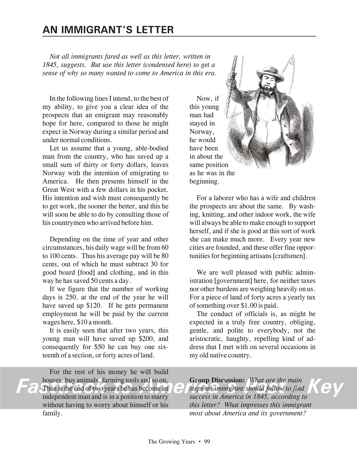| Fasttrack
to America's Past Teacher Key |
|
| Fasttrack
to America's Past Teacher Key |
|
 Page 99 |
Page 99 - An
Immigrant's Letter The reading selection This letter will give students a better sense of the prospects that immigrants faced in the decades before the Civil War. It is especially vivid because of the details it includes about pay and expenses. The author is a Norwegian immigrant who no doubt was already accustomed to hard work on a farm. He describes life in "the Great West" of America. Remind students that he is referring to the area that today is called the Midwest - states like Michigan, Indiana, and Wisconsin. Certainly many immigrants did not have the good fortune that this Norwegian experienced. But many did share the same success he had in creating a better life for himself. Letters like this one sent back to "the old country" had a big impact, and encouraged many others to leave for America. The picture The picture shows an immigrant arriving on a sailing ship. Remember that an immigrant to America is emigrating from some other country. Group discussion
questions This Norwegian
immigrant writes that
the path to success in America is pretty straight-forward: get to
work, save, and get established on your own two feet. Equally impressive, the letter says, is the American system of government and the widespread attitude of equality. Taxes, he points out, are low. A person's hard work, therefore, was not taxed away to support an aristocratic ruling class such as that found in much of Europe at the time. He also notes, with obvious appreciation, that government officials were polite, not haughty or snooty toward ordinary people. It is difficult for Americans today to fully appreciate the great social and political revolution that this immigrant is commenting upon. But to most people arriving in America from Europe in the 19th century, the change was remarkable and exhilarating. |
|
Copyright Notice
Copyright 2018 by David Burns. All rights reserved. Illustrations and reading selections appearing in this work are taken from sources in the public domain and from private collections used by permission. Sources include: the Dover Pictorial Archive, the Library of Congress, The National Archives, The Hart Publishing Co., Corel Corporation and its licensors, Nova Development Corporation and its licensors, and others. Maps were created or adapted by the author using reference maps from the United States Geological Survey and Cartesia Software. Please see the home page for this title for more information. |